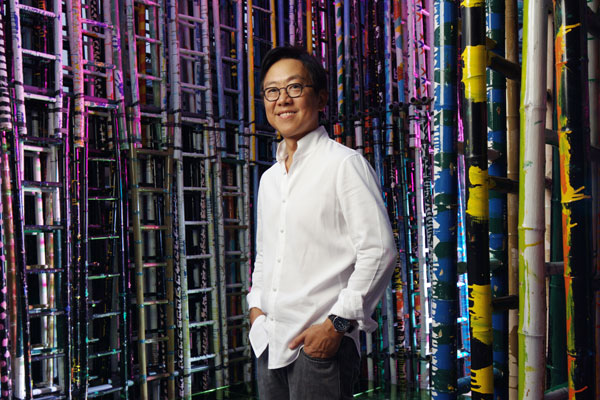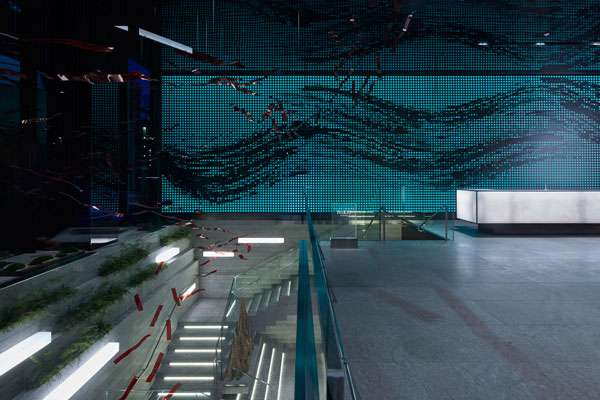Hong Kong architect William Lim talks to Christie Lee about Chinese architecture and his obsession with conceptual art.

March 4th, 2015
William Lim might be the only architect in Hong Kong who’s known as much for his vast art collection as his design projects. In fact, art was his first love – “I was obsessed with pastels” – architecture only came second when, upon his father’s chiding, he entered the prestigious Cornell University as a student of architecture. “My portfolio had nothing to do with architecture. I have no idea how I was accepted in the first place!” Upon nabbing a Bachelors and Masters in architecture in the early 1980s, Lim found his footing as an architect in Boston. Five years later, he packed his bags for Hong Kong and subsequently found CL3, a multi-disciplinary architecture firm with offices in Hong Kong, Shanghai and Beijing, in 1992. Having just completed the Millennium Mitsui Garden hotel in Ginza, CL3 has several projects in the pipeline, including a 28-storey multi-purpose building – “I’d fill it up with galleries if it were up to me” – in Central, due for completion in 2017. The multi-hyphenate is also set to design LANDMARK’s “Take Another View on Art” exhibition installation during Art Basel Hong Kong this month.

Millennium Mitsui Garden hotel
How was architecture being perceived back in the 1970s?
Architecture was treated very much as a service industry back in the days. It used to be quite a mundane profession when all an architect needed to do was maximise the square footage of the square. It has definitely become more personal since then. Developers are willing to spend more to enhance the aesthetic value of a project.
The late 1970s – that was also when Post-modernism became a part of the design landscape?
Actually, it was a terrible period for architecture. A lot of the new stuff coming out was gimmicky and few of the inventions had anything to do with architecture itself. When you think of good architecture, the design needs to be integrated into the space rather than applied as a decorative feature.
Were there any influences early in your career?
Le Corbusier, Mies van der Rohe and Frank Lloyd Wright. Le Corbusier’s idea that the building’s structure should be separated from its enclosure was obviously very important in the development of modern architecture, while Wright was instrumental in advancing the Art Deco movement.
You’re a prominent art collector. Does being an architect draw you to certain types of artworks?
I understand conceptual art better. Due to my academic background, I also like works that deal with time and space, be it in an architecturally-driven manner or in a more abstract way. I think Lee Kit and Tozer Pak deal with that.
In an increasingly globalised world, what does ‘Chineseness’ or ‘Asianess’ in architecture mean?
I’d hate to reduce ‘Chineseness’ to a pure symbol, as you can easily fall into the trap of building a ‘themed’ mall, park and whatnot. Some of the works by Frank Lloyd Wright are quite Orientalist, yet you don’t see any blatant Asian motifs. Personally, I like using natural materials, as well as applying the yin/yang philosophy in my projects. Water also features strongly.
Could you elaborate on the use of natural materials?
I love using wood and raw concrete, where the nature of the materials really comes through. I just came back from a trip to India and quite a number of architects are working with sandstone. There is a Chinese saying: if you’re only killing a chicken, why use the knife reserved for butchering a cow? The same philosophy applies to architecture.
Why has ‘porosity’ enjoyed such presence in your projects?
Space is an important part of my design as I hate compartmentalisation. There are two types of transparency: literal transparency, which allows one to peer at the next space, and implied transparency, where tools such as mirrored surfaces are used to connect spaces.
Any regrets at not pursuing the visual arts?
I used to think that architecture and art were two separate disciplines, but I’m beginning to see more of my artistic eye in my architectural projects. Michelangelo was an artist as well as an architect. Up until recently, Le Corbusier had always been considered first and foremost an architect – what people didn’t realise was that his artworks could also stand on their own.
CL3
cl3.com
A searchable and comprehensive guide for specifying leading products and their suppliers
Keep up to date with the latest and greatest from our industry BFF's!

The Sub-Zero Wolf showrooms in Sydney and Melbourne provide a creative experience unlike any other. Now showcasing all-new product ranges, the showrooms present a unique perspective on the future of kitchens, homes and lifestyles.

Suitable for applications ranging from schools and retail outlets to computer rooms and X-ray suites, Palettone comes in two varieties and a choice of more than fifty colours.

Savage Design’s approach to understanding the relationship between design concepts and user experience, particularly with metalwork, transcends traditional boundaries, blending timeless craftsmanship with digital innovation to create enduring elegance in objects, furnishings, and door furniture.
The internet never sleeps! Here's the stuff you might have missed

Leading the field in terms of ergonomics, this high-end office furniture from Buro is also designed with the evolving needs of the modern workplace in mind.

Third in the series of boutique hotels under the Lloyd’s Inn brand, Lloyd’s Inn Kuala Lumpur bring the immediacy of nature to the new high-rise hospitality experience in the heart of a bustling city.